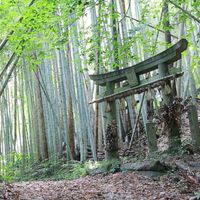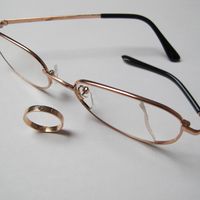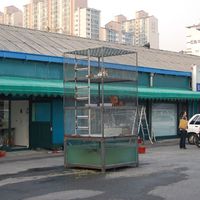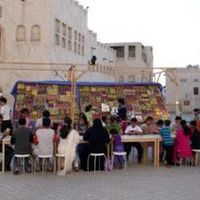Outside the mainstream | independent project spaces and artist-run initiatives in Japan
 Artists Jasmina Llobet and Luis Fernández Pons spent a month in Japan in September 2011 on a residency at Akiyoshidai International Art Village. They then travelled through the country visiting independent project spaces and artist-run initiatives. In this article they look at how these spaces function and their place within the contemporary arts scene in Japan.
Artists Jasmina Llobet and Luis Fernández Pons spent a month in Japan in September 2011 on a residency at Akiyoshidai International Art Village. They then travelled through the country visiting independent project spaces and artist-run initiatives. In this article they look at how these spaces function and their place within the contemporary arts scene in Japan.Japan has major contemporary art museums, but also very interesting smaller independent art initiatives and exhibition spaces, which play an important role in the creation of discourse in the field of contemporary art. It is particularly difficult to start and run such initiatives in Japan, usually reliant on the commitment of dedicated individuals. This article aims to give an insight into some of those non-commercial art spaces. How is it to work in such a space? How are they financed? And why do these people put their energy and money into such projects?
For some time, as artists we have been interested to learn more about exhibition spaces in Japan that are not corporate or public-funded, but independent and with a focus on experimental art projects. These non-commercial, private initiatives are places where, in our opinion, some of the most interesting art projects are created and exhibited, projects that rarely find their way into mainstream circuits.
In Japan it is not common to receive funding from public institutions, and private sponsors are difficult to find, particularly after the devastating earthquake and tsunami and the Fukushima nuclear disaster. Independent art spaces only exist due to committed individuals and non-profit engagement. This lack of funding explains a typical Japanese phenomenon: why artists participating in exhibitions or residencies often have to search for funding themselves for flight, production and other expenses.
Here are four examples of independent exhibition spaces in Japan running for some years:
Ongoing (Tokyo)
Ongoing was created in 2002 as a mobile platform for art projects in Kichijōji area, 30 minutes west of Shinjuku Station. It is quite central given the huge distances you find in Tokyo. The area is a mix of small houses, shopping streets and Japanese style micro-restaurants (some can serve only 2 people at a time!). Kichijōji used to be a very popular area for artists with an alternative reputation. Now it has changed a bit, perhaps because rents have been getting higher. Kichijōji has a very lively atmosphere, with crowds of young people in the streets. But you can also find the peaceful Inokashira Park, a beautiful place to wander around the boating lake.
Nozomu Ogawa, director of Ongoing, explained his vision and described the projects realised in recent years. It is a traditional two-storey Japanese house with a great view from the roof top, which artists have also used for projects.
As Mr Ogawa explains, artists exhibiting at Ongoing have no commercial pressure and can concentrate on experimenting and developing innovative art projects. Their focus is mostly performance, installation and video, although there have been projects of all kinds, most site-specific. Some projects have even been dangerous for the safety of the building. For example, one artist filled the first floor with water. An architect warned against that intervention as it might damage the structure of the house but Ogawa took the risk. “Traditional houses are stronger than they look” he said, amused, and we could see how committed he is to the Ongoing project and would be open to the challenge of any interesting idea from an artist he likes.
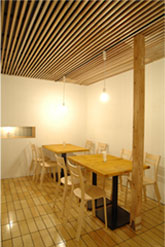 Ongoing has no regular support from any institution. They finance themselves through Ogawa's university teaching job and also with the ground floor coffee shop, a meeting point for artists living in the area. The atmosphere is nice and quiet and has an extensive art library of contemporary art books and magazines for customers to browse.
Ongoing has no regular support from any institution. They finance themselves through Ogawa's university teaching job and also with the ground floor coffee shop, a meeting point for artists living in the area. The atmosphere is nice and quiet and has an extensive art library of contemporary art books and magazines for customers to browse.A coffee shop inside a gallery is a sort of taboo in Europe, but common in Japan, and we have also seen some in South Korea. Even commercial galleries occasionally do this, as sales of artworks barely pay the rent. So, who says this is off-limits? We find exhibition spaces in Asia are very creative and with fewer “unwritten rules” than in other places.
Youkobo (Tokyo)
Youkobo is an artist residency and exhibition space in the multicultural area of Ogikubo, said to be the birthplace of Tokyo-style ramen noodles. It was nice to walk around the streets of this neighbourhood, it felt different from other places in Tokyo – less tourist activity and many small ordinary stores. In Ogikubo we somehow got the feeling of what everyday life must be like in Tokyo.
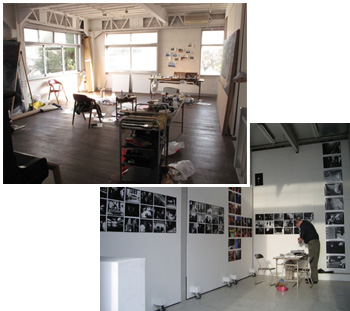 Youkobo is the private initiative of Hiroko and Tatsuhiko Murata, a well-known couple on the Tokyo art scene who have worked on art projects for many years. The residency consists of two separate buildings, one where artists live (housing up to 2 artists) and the other for the office, studio and exhibition space. The main building used to be a sanatorium for tuberculosis patients where Tatsuhiko Murata's father treated his patients until the 70's. This two-storey building is being renovated to enlarge the exhibition space. The recent Tohoku earthquake caused some damage to the upper floor of the house but fortunately, traditional Japanese houses seem to be really strong.
Youkobo is the private initiative of Hiroko and Tatsuhiko Murata, a well-known couple on the Tokyo art scene who have worked on art projects for many years. The residency consists of two separate buildings, one where artists live (housing up to 2 artists) and the other for the office, studio and exhibition space. The main building used to be a sanatorium for tuberculosis patients where Tatsuhiko Murata's father treated his patients until the 70's. This two-storey building is being renovated to enlarge the exhibition space. The recent Tohoku earthquake caused some damage to the upper floor of the house but fortunately, traditional Japanese houses seem to be really strong.CAS (Osaka)
In Osaka, the third largest city in Japan with over 2.5 million residents, it is still quite difficult to find the type of project we were looking for: independent, non-commercial art spaces created and run by passionate individuals. But they are there and, surprisingly, some have been running for a really long time. This is the case with CAS, a platform where artists have been given a space to realise their projects, even the craziest ones. We met Takashi Sasaoka who started CAS in 1998 and runs the project.
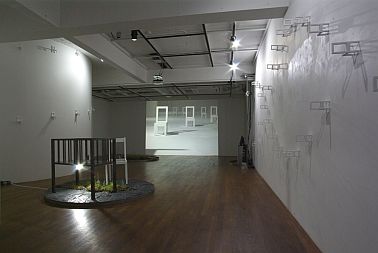
CAS is in one of Osaka's most lively areas: Namba. This part of the city is full of young people and known as Osaka's entertainment district, with restaurants, bars, arcades, shops. Director Sasaoka decided to establish a new space here dedicated to non-commercial and experimental art projects. The gallery shares a building with other cultural initiatives.
From the exhibition programme in recent years, we found that this project space has been showing some truly experimental, ground-breaking projects in media art, installation and sculpture. CAS's exhibition programme is planned by a group of independent curators, museum curators and university professors, invited by Mr Sasaoka. They have also realised exchange programmes with institutions like Künstlerhaus Dortmund, in Germany.
Studio Kura (Itoshima)
Studio Kura is in the countryside, near Fukuoka in southern Japan, between rice fields, mountains and the seashore. Director Hirofumi Matsuzaki started the programme in 2007 and to date has invited 12 artists to spend one month living in rural Japan to realise and exhibit an art project.
In 2009 we had the chance to spend time on a residency at Studio Kura and were very grateful and touched by the hospitality and friendly atmosphere. One special detail: Studio Kura provides a typical Japanese dinner every evening, with delicious ingredients coming directly from the surrounding area: sweet potato, sashimi raw fish and many vegetables we had never seen before.

Studio Kura is an independent, self-financed art project. The residency culminates in a solo exhibition in the artist-run space IAF, in central Fukuoka. Artists can also exhibit on site at the Studio Kura gallery, where we did our final presentation.
Artists’ stays at Studio Kura are often based on exchange projects with institutions in other countries, otherwise artists have to find funding to cover their expenses. The focus is on painting and drawing, although dance and installation artists have also been hosted.
-------------------------------------
While the phenomenon of artist-run-spaces is widespread with a long tradition in other cities and countries, in Japan there are few such projects. Mostly because rents are so high, often such projects are born and disappear after a short time. But others have been working for years with a solid agenda. These essential initiatives are doing an important job in the Japanese art scene.
People running such spaces often have to combine their art activity with other jobs, for example, teaching at university. Especially nowadays it is hard to find alternative funding sources, so they must come up with new ideas all the time: membership fees, admission costs for lectures, performances and events, private sponsorship, donations and grants. It’s not easy.
But surprisingly, in spite of the difficulties of working outside the commercial art scene, there are still truly committed people who start and run such projects.
Jasmina Llobet and Luis Fernández Pons are a Spanish visual artist collective (Llobet & Pons) based in Berlin and working together since 2002 across the fields of installation, object sculpture and art in public space. They both hold a Meisterschüler degree in Fine Art from Berlin University of the Arts. Very interested in exchange programmes and artist initiatives, in the last years they have participated in many residencies in European and Asian countries, for example at AIAV Akiyoshidai International Art Village in Japan; Seoul Art Space Geumcheon in South Korea and Platform Garanti in Turkey. And also they have presented their works at international art spaces like Studio1 - Bethanien or The Process Room at the Irish Museum of Modern Art.
See the first article in this series - Exchanging artistic ideals and values (on artists' residencies in Japan)
See also Culture360 2010 article 'Nomadic Artists'
Similar content
03 Dec 2010
from - to
14 Oct 2011 - 30 Nov 2011
23 Apr 2012


